Since May this year, I’ve had a wedding ring at my finger. This means that my life has changed a lot. Not on a day to day basis because my partner and I have been living together for for years already, but because marriage gave a new flavour to our relationship, which is now tainted with a greater sense of… long term. Hence we started to speak more openly and in more details about our long term projects, aspirations, hopes, etc. Even though that exercise of speaking to each other was highly valuable, we were determined not let those ideas evaporate and our aspirations remain only a dream. That is how our Kanban adventure started.
Being a management consultant (I am sure you got that at this stage J), and working with the Agile principles on a daily basis, I was convinced for a while that several of those principles would be relevant in a household. Therefore I seized the opportunity that was in front of me: I bought a white board, some sticky notes, a few markers, and we made the decision to try and make all those common projects a reality using a Kanban.
And here is our Masterpiece:
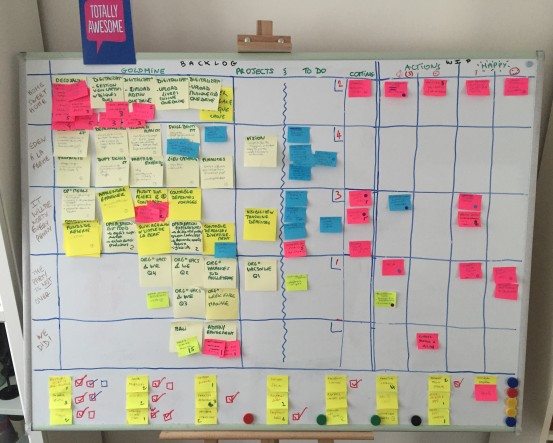
I am almost a bit emotional when I look at it as it reminds me of all the knowledge, ideas, thinking and effort we put into it.
It doesn’t look like much, but I promise you there is much more than you imagine.
What is a Kanban? (reminder)
Just a short reminder on what a Kanban is. It means signboard in Japanese, and this is what it is: a board divided into multiple columns, each representing an activity of a sequential process. And when there is a task to do, it starts on the left of the Kanban and goes through all the board towards the right, until the final column (usually Done). Therefore, a kanban is a bit of a map of your work to and in progress.
Kanbans are at the centre of the lean approach aiming to deliver things with the minimum waste and to foster continuous improvement. If you want to know more on Kanban, please read my article about the various techniques of managing projects.
But, in brief, here are the principles of Kanban:
- It is a tool to visualise the work to do and in progress by moving little cards across the board to represent their status
- It is not fixed. It is a flexible tool, adaptable to any situation, and improvable over time
- It is used to limit the work in progress. You shouldn’t put more than x tasks in the “in progress” column (you defined the number) in order to avoid bottlenecks and to keep the focus on what has been started
That’s about it really… and believe me, its simplicity makes its strength!
How is our Kanban structured?
This is how our Kanban is structured today (I insist on the TODAY as it hasn’t been like this since the beginning and it is unlikely to remain exactly like this forever):
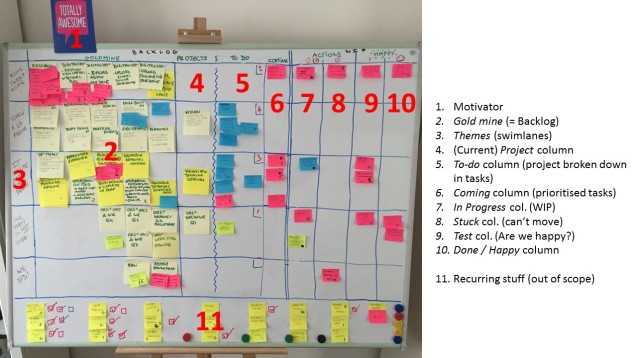
Vertically:

- The gold mine – this is the name we gave to our backlog. Well honestly we didn’t like backlog (it’s still written at the top but we don’t use it any more). It reminded us of work and changing the name was a way for us to get more ownership out of new system. It was important for us to label it with a phrase that was reflecting all the positive side of our projects. The gold mine contains a full high level backlog for the topic in scope, which means that it fixes the ultimate end of the project as we have it in our mind today. Each yellow post-it represents an item in the backlog, something we’ll have to do in order to fulfill our dream.
- Projects – This column contains only one backlog item that we prioritised and we want to deliver. It is short term enough to give us tangible benefits to look for, but long-term enough to keep us busy for a week or two. We created it because we felt initially that were was a layer missing between our ultimate purpose and day to day tasks. We needed something in the middle to drive us and give us the feeling that we are always moving towards tangible success. Now, this layer actually constitutes the unit of our gold mine.
- To-do – This is the prioritised project, broken down into actionable tasks. Our project (yellow post-it) is still too big to represent one action on the Kanban. It would stay forever in the “in progress” column and that would demotivate us. Plus we would have to add lots on details on the post it in order to explain what we need to do to complete it. Therefore, our solution was to break it down into smaller actions, each fixed on a smaller sticky note.
- Coming – The prioritised actions for the next day. We are only allowed to pull into In progress any of the actions that is in this column. We are usually a bit more loose and open during the week-end on this one, and a bit stricter during the work week.
- Actions – In Progress – Represented with the two-arrow symbol, this column contains all the tasks that have been initiated, and that we are still able to progress forward. This is our pure work in progress
- Actions – stuck – Represented by a little forbidden symbol, it gathers tasks that cannot be progressed without input from an external source. It does not depend on us to move forward
- Happy – ? – This is our test column, and I personally think this is one of the most important one. When we’re done with something but are waiting for the result to be achieved, that’s where we put the task. I think that this gap between “I’m done” and “the task is over” is a major problem in to-do lists, but something that can be fixed easily with Kanbans.
- Happy – Happy – A smiley face, representing the task as completed and the result achieved. We let our achieved output pile-up until our weekly meeting
Horizontally:

Swimlanes represent themes. There are multiple projects that my wife and I are managing simultaneously, and therefore we have a sub gold mine for each of them. However, in the To do column, each project is prioritised with an indicative priority order, reflecting which one is our current priority overall. For example, as we are getting closer to Christmas, the project related to Family & Friends was the top priority. However, in the new year, it is very likely that we are going to prioritise some more personal stuff for a while as this period is usually pretty quiet.
How does our Kanban work?
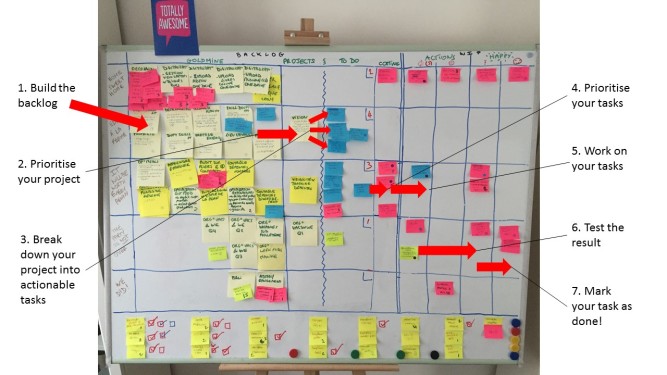
Project initiation:
- We build the backlog, or gold mine (more on that later…)
Weekly:
- We move items from the gold mine to projects when we want to work on the next project in line (always the most important / obvious) – this is the item we are going to work on for the next couple of weeks or so
- We break down this project into actionable tasks (usually those tasks represent up to 1 hour of work roughly)
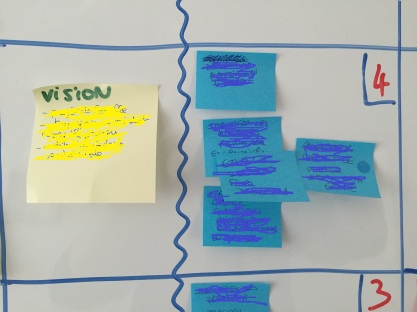
We prioritise the projects from 1 to 5 based on the overall importance

We remove the Happy tasks and acknowledge our output
Daily:
- We move the tasks from To-do to Coming to highlight the ones requiring action in priority
- We highlight the fast track actions with a little sticker – reflecting urgent & important actions

Ongoing
- We move them through In progress, stuck, ? and happy based on achievements
Also, for time-sensitive actions that need to be actioned at a certain point in time (eg check-in on a flight), we usually put them into our calendar until they need to be actioned, then we put it on our Kanban with a fast track sticker.
For time sensitive actions that can be performed at any time, we put them on our board and write the due date on the card.
Our Kanban itself is a couple’s project
Our Kanban and the system it supports are still very young (c. 2-month old), and there are another thousand ways we can improve it in the future. However, both my wife and I acknowledge that it does work, and that this is the right tool for us. Why?
Simple because it is a simple tool, with very few rules, and which is open to be improved and adjusted in many ways so that it can fit the personality and the needs of the people using it. My wife was new to Agile and Kanban until I brought them home a few months ago. And very quickly, she adopted it, and made a lot of suggestions in order to adapt it to make it friendlier for her and for us. For example, she had the idea of removing the business jargon and turn it into a more personal and positive one. She also had the idea of putting little stickers to highlight the fast track tasks etc. This is one of the most powerful strengths of Kanban: it includes everybody, give a place to everybody working with it.
Our Kanban is a bit of a project in itself for us, something that belongs to us, that we are proud of, and that we are determined to develop over time. It contains most of our aspirations together, and is the only place that does so, that’s why we are much dedicated to take care of it.






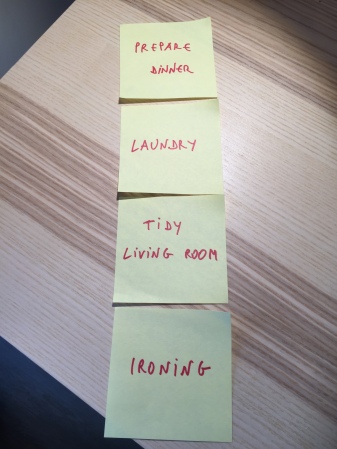


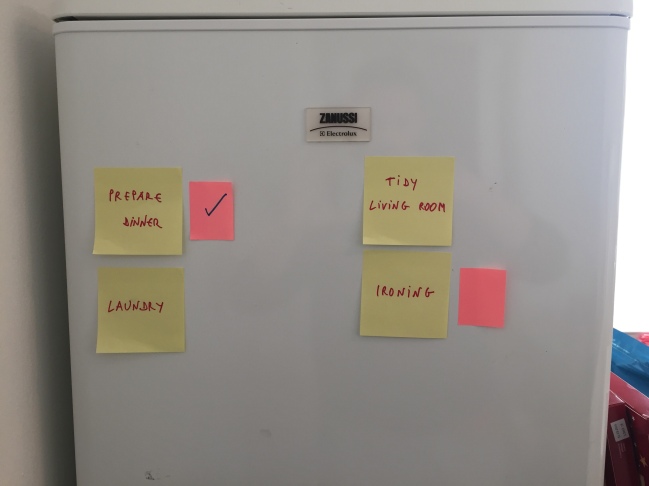
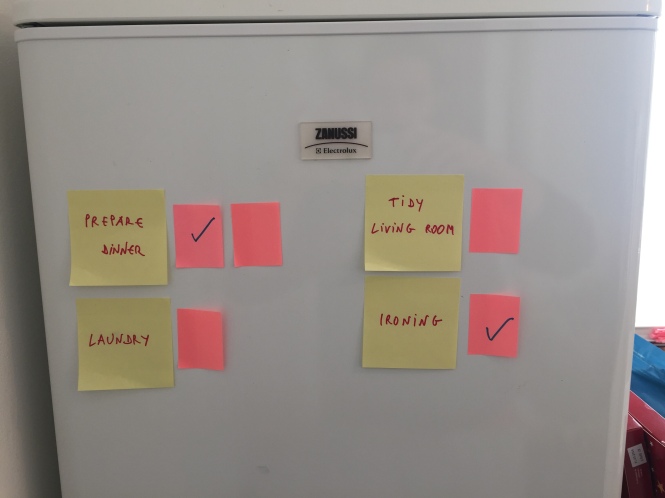
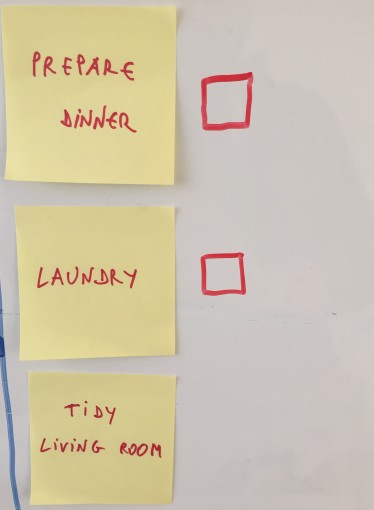
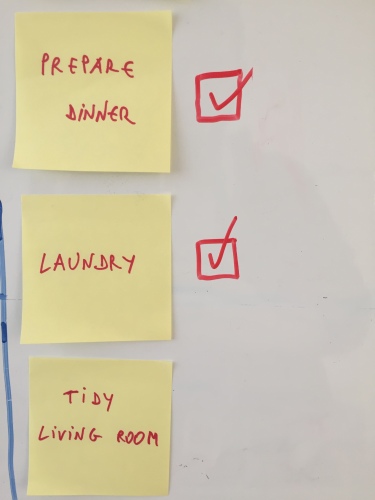
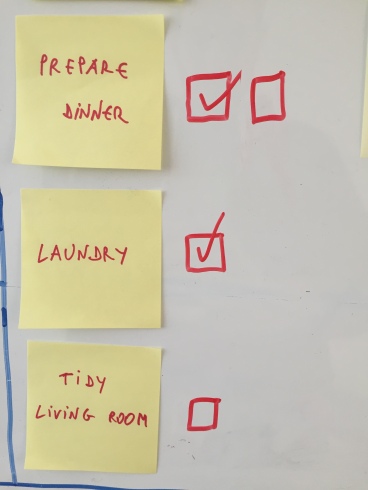
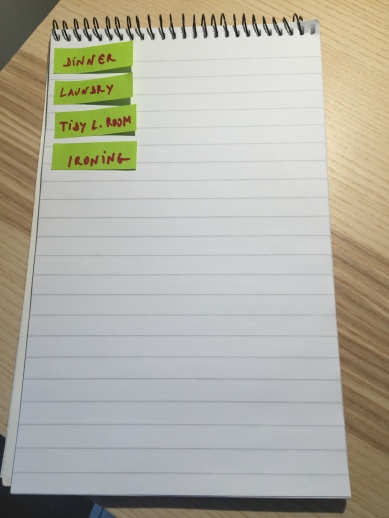
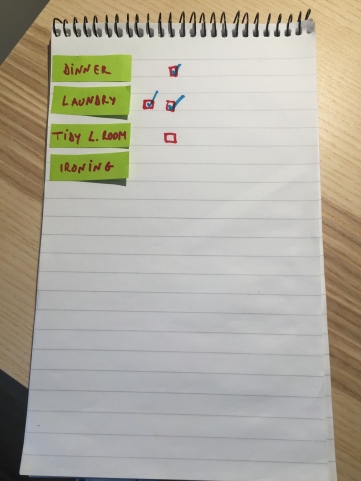
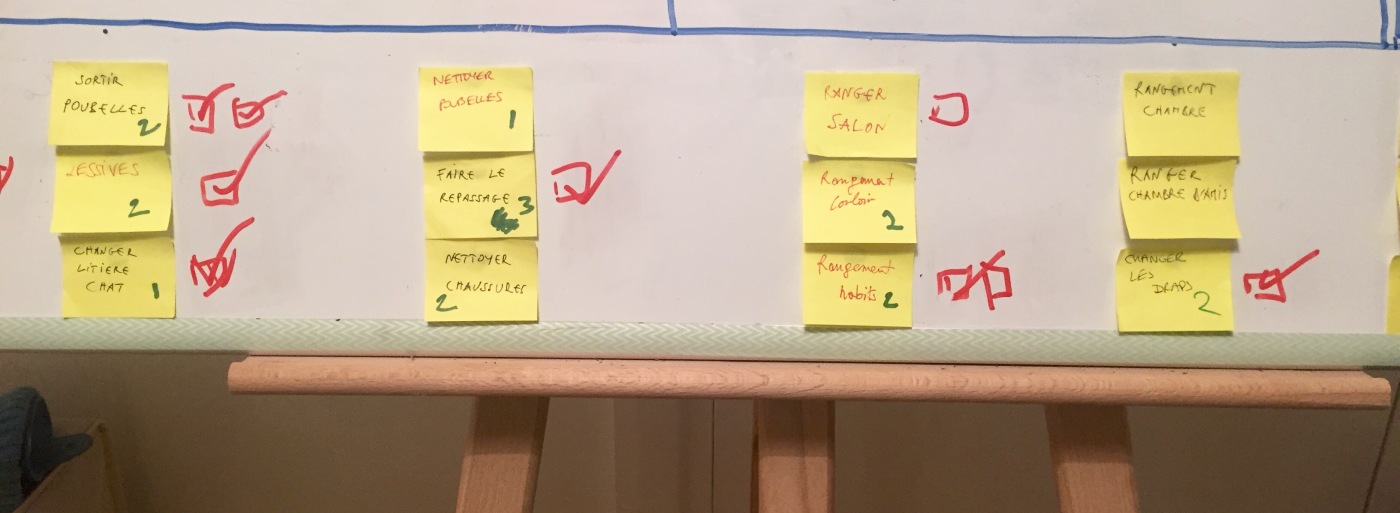
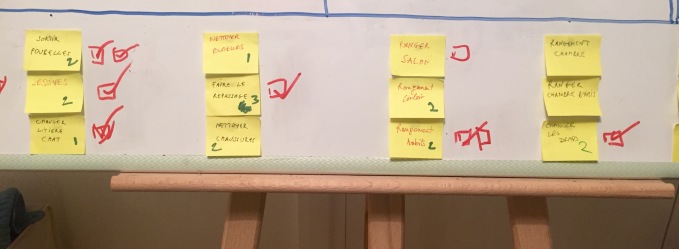



Recent Comments